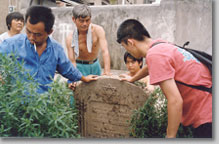
 |
|
|
|
|||
|
PERSONAL JOURNAL By James T.
Areddy |
 |
|||
Angling his
video camera next to a filthy, algae-covered creek, trying to get
a better look Credit another historic find to Shanghai's self-styled tombstone sleuth. "I knew it was Jewish, so we dug it out," says the 37-year-old Israeli, who is on a mission to reassemble a remnant of Shanghai's Jewish past, one headstone at a time. Mr. Bar-Gal is discovering the story of Shanghai's tombstone Diaspora. Just as more than 20,000 Jewish people who had found refuge in the city during the late 1930s later dispersed to Israel and elsewhere when China's Communist Party came to power, political tumult led to a scattering of the headstones that once filled the city's four Jewish cemeteries. Mr. Bar-Gal estimates their number at around 3,700. So far he has found 70 of them, as well as many Christian headstones, mostly in poor villages among the crisscrossing canals surrounding Shanghai that are home to migrants from all over rural China. They have put the headstones to use as washboards, floors, tables, steps, bridges and even parts of home foundations. "They see it as a useful stone, [and] not as political or racist" to use them in those ways, Mr. Bar-Gal says, noting that most are happy to take his standard $10 payment for each stone. Their practical attitude sits well with the shaven-headed photojournalist, who isn't religious and has little time for questions about what some might consider a ghoulish hobby. "I'm not collecting bodies, I'm only collecting stones. They have no holiness." Traces of the
cemeteries appeared lost until last year, when Mr. Bar-Gal's job
as a tour guide Mr. Bar-Gal, whose September 2001 posting to Shanghai as an Israeli TV journalist fell through after he arrived, has documented every step of his yearlong headstone hunt. He has shot extensive video footage and taken numerous photographs, both dwelling heavily on the rural recovery process and negotiations with villagers. What pushes him forward is "Jewish sentiment combined with Jewish history and treasures." For him, the marble slabs, most topped with a Star of David and etched with five Hebrew characters denoting burial, are a physical reminder of Shanghai's rich Jewish heritage. "The Jewish world is very small, and people feel a responsibility for each other," he says. He's also driven by the thrill of a long-odds chase that he says sometimes makes him feel like Indiana Jones. "The first time I twisted a stone and saw the Hebrew writing, it was very emotional. I'm discovering what a lot of people are looking for," he says, referring to the families of the deceased, and also to the sense of mystery that has long surrounded the apparent disappearance of the city's Jewish graves. Shanghai's first Jewish community, Sephardic traders from Baghdad, arrived in the 1840s, many building fortunes on tea and opium, and leaving landmarks that stand today. They include the Gothic-style Peace Hotel, built in 1929 on Shanghai's Bund by the Sassoons, who at the time were among the city's most prominent families, and the sprawling Kadoorie mansion, built by one of Asia's wealthiest business dynasties in the former French Concession. Mr. Bar-Gal, however, thinks Shanghai has a greater significance as a safe haven, starting with the 1917 arrival of Jewish people fleeing the Bolshevik Revolution in Russia. He also thinks of the late 1930s when, even under Japanese occupation, the city offered sanctuary from Nazi persecution to thousands from Eastern Europe. "We Jewish people regard Shanghai as a city of refuge," he says. But in 1958, nine years after coming to power, the Communist Party ordered all foreign graves dug up and relocated to a new "international" cemetery, where the Jewish ones were mixed into a Muslim burial ground. The following decade, during Mao Zedong's Cultural Revolution, the headstones were removed from the graves and dumped in the vast wetlands surrounding Shanghai. Mr. Bar-Gal is now trying to round up funding to propel his pet project forward, envisaging everything from a documentary and book, to a Web site and even a museum. He is getting some help along the way from benefactors in Shanghai's tiny Jewish community, and the Israeli consulate. "The main thing is to display them in Shanghai," he says. Claiming no
ownership of the stones, now stored in a benefactor's warehouse,
Mr. Bar-Gal says they belong to families. The problem is that not
all of the families want them. One tombstone, that of eye doctor
Charlesworth Percival Rakusen, who died in 1958, was easily traced
to the European matzo bread empire. --- Mr. Areddy is
a correspondent in the Shanghai bureau |
||||
Home
| Contact Us | Copyright
2006 Shanghai Jewish memorial |